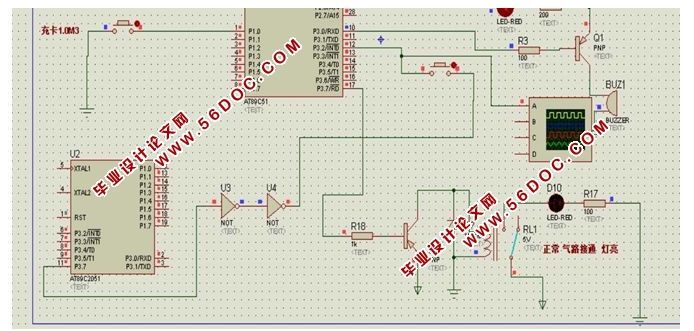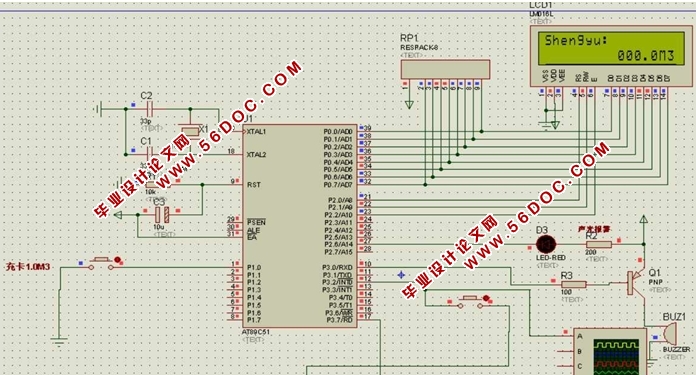基于单片机的燃气自动抄表系统设计(附仿真图,程序)
来源:56doc.com 资料编号:5D19084 资料等级:★★★★★ %E8%B5%84%E6%96%99%E7%BC%96%E5%8F%B7%EF%BC%9A5D19084
资料以网页介绍的为准,下载后不会有水印.资料仅供学习参考之用. 密 保 惠 帮助
资料介绍
基于单片机的燃气自动抄表系统设计(附仿真图,程序)(课题说明书,开题报告,中期检查表,论文8000字)
摘 要 随着科技的飞速发展,物联网技术已经越来越成熟,以大数据等核心技术为主体构建的物联网络,对我们的生活造成越来越重要的影响,而本文所设计的燃气自动抄表系统是以NB-IoT(窄带物联网)为传输信号的载体,以STC89C52单片机为基础,采用无线传感网络对居民的燃气信息智能采集,大大提高燃气抄表的准确性。本文对传感器原件,信号调整部分,信号发射部分以及信号接收模块进行了设计,通过程序运行得出数据。数据表明:以NB-IoT为传输信号的载体,以单片机为基础的燃气自动抄表系统技术更先进,效率更高、更安全。
关键词 物联网; NB-IoT; 数据采集; 单片机;
Design of Gas Automatic Meter Reading System Based on Single Chip Microcomputer
Abstract With the rapid development of science and technology, the technology of Internet of Things has become more and more mature. The Internet of Things, which is based on big data and other core technologies, has a more and more important impact on our lives. The gas automatic meter reading system designed in this paper is based on NB-IoT (narrowband Internet of Things) as the carrier of transmission signals, STC89C52 microcontroller as the basis, using wireless sensor network to live in. Intelligent collection of civil gas information greatly improves the accuracy of gas meter reading. In this paper, the original sensor, the signal adjustment part, the signal transmitting part and the signal receiving module are designed, and the data are obtained by running the program. The data show that the technology of gas automatic meter reading system based on single chip computer is more advanced, more efficient and safer with NB-IoT as the carrier of transmission signal.
Keywords Internet of Things; NB-IoT; Data Acquisition; Single Chip Microcomputer
总体方案设计
该无线抄表应用系统,总体上由以下四个基本部分构成:(1)传感器元件;(2)信号调整部分;(3)信号发射模块;(4)信号接收模块。
各部分的主要组成及功能:
(1)传感器元件:本设计采用红外反射式光电传感器,它由红外发射管和红外光敏管组成,如图2-2所示:当表盘转一周,在刻线处反射红外光信号,从而接收一个光脉冲信号。
(2)信号调整:信号调整部分由脉冲计数器和信号转换器组成,脉冲计数器用来计数一定时间内传感器送来的总的脉冲个数,信号转换器将总的脉冲信号个数通过信号转换,转换成总的用电量,然后传送给信号发射模块。



目录
摘要及关键词 1
1 绪论 1
2 总体方案设计 1
2.1 NB-IoT介绍 3
2.2 工作模式 4
2.3 信号的输入 4
2.4 数据的传输 5
2.5 NB模组的设计 5
3 硬件方案设计 5
3.1 单片机最小系统 5
3.2 信号采集模块 6
3.3 信号存储及转换 7
3.4 看门狗电路 7
3.5 按键电路 9
3.6 显示电路 9
3.7 串口通信电路 11
4 软件方案设计 11
4.1 信号传输程序设计 11
4.2 信号接收程序设计 12
4.3 脉冲计数程序 12
4.4 按键程序设计 12
4.5 显示模块程序设计 14
4.6串行通信程序设计 15
5 结论 15
参考文献 16
致 谢 18
附录 19
|







